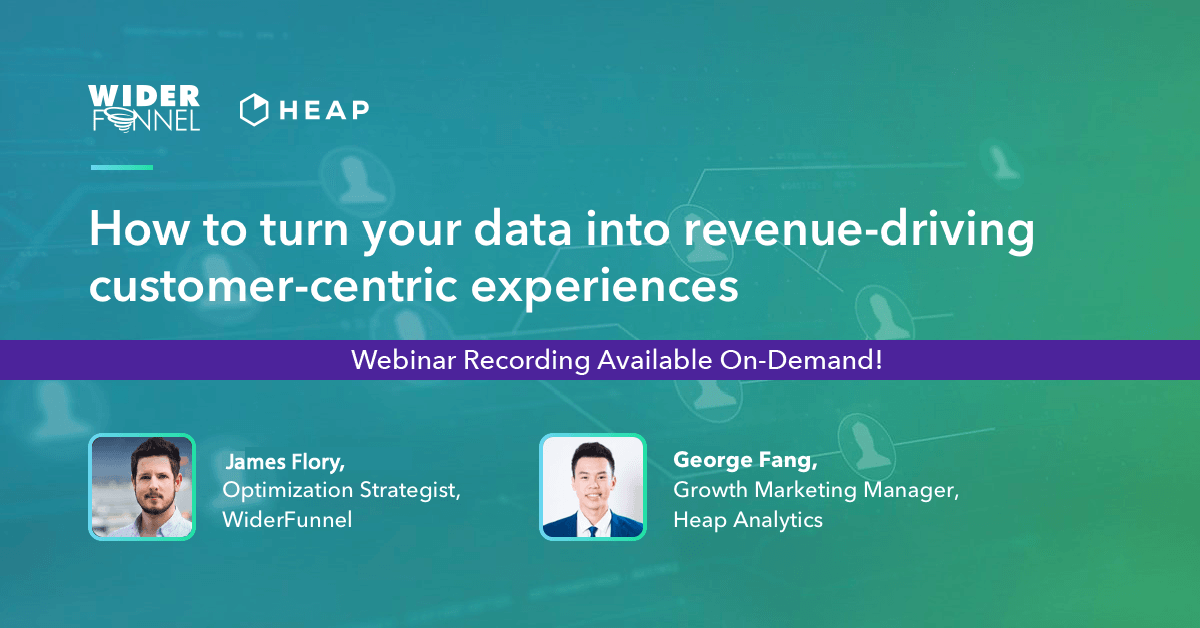3 Datasets Worth Leveraging for your Experimentation + New Webinar
On August 14th, 2018, we put on a webinar with WiderFunnel, titled How to turn your data into revenue-driving customer-centric experiences. Check out the recording! Before you do, I wanted to spend a little time talking about the kind of data that marketing teams have access to today, and some ways that they can leverage that data. Generally, marketing teams have two ways to grow their revenue: 1) Spend more money on customer acquisition programs, or 2) Make the money you’re already spending go further.
How do you achieve #2? Experimentation. If you run an A/B test that causes your checkout conversion rate to go up, then you’ve produced growth without spending any additional money.
However, there’s a wide variety in the effectiveness of experimentation programs across companies. ConversionXL found that on average 1 in 7 A/B tests actually produce a statistically significant lift, but for some companies that number can be as high as 1 in 3, which is a huge difference in the rate of improvement.
This level of variance illustrates why it’s important to have strong hypotheses for tests to maximize your chances of them having an impact. The best way to come up with strong hypotheses is with strong data. In this piece we’ll explore a few datasets you may already be collecting about your customers that can inform your experimentation ideas.
Dataset #1: Email statistics
Your email service provider (e.g. ExactTarget, Marketo, MailChimp, etc) almost certainly has a wealth of data on how customers are interacting with your email campaigns. There’s also a lot of data available online about standard industry benchmarks for things like open rates, reply rates, unsubscribes, clickthroughs, etc.
Take a look at your email data and compare it to these benchmarks. If you see a discrepancy with, for example, your open rates, then this provides a ripe opportunity for experimentation. Maybe A/B testing your email subject lines will lead to a lift in open rate, for example.
Another thing to look for is differences between campaigns. If you see that your open rate is the same across all your email campaigns no matter what subject, this may tell you that your email subscribers are treating any of your emails the same based on the sender and don’t really read the subject line. However, if your open rates vary drastically, this tells you that the subject line (or perhaps other variables like time of day) matters a lot, and is something you may want to run experiments against.
Email is still a key way many businesses interact with customers today, and it’s an interaction that’s often ripe for optimization and experimentation. Bringing your email data into your experiments can open up new insights and drive better results for your business.
Dataset #2: Longitudinal user data
Most analyses are focused around short-term questions like analyzing conversion rates of a specific flow. However, some of the most interesting insights can come from taking a more long-term view of what your customers are doing.
One of our e-commerce clients found that customers who spent more time browsing product pages prior to their initial purchase were more likely to come back and make repeat purchases, as opposed to customers who went straight to what they were looking for. This inspired an idea for an A/B test: they re-designed the product search flow to promote recommended and related products. This actually lengthened the amount of time customers spent before making a purchase, and even reduced the first-time conversion rate by a tiny amount. However, the reduction in conversion was more than offset by a much higher repeat purchase rate.
Exploring these sorts of quirks in your overarching customer behavior can give you great experimentation ideas that can potentially have a strong impact for you. Bringing your customer data into the picture longitudinally can empower your tests and lead to big wins.
Dataset #3: Behavioral segmentation data
Learn more about behavioral segmentation here!
When you first implement an experimentation program, there may be lots of “low-hanging fruit” experiments that fix large deficiencies in your acquisition funnel. Soon, however, you’ll need to get more creative to find consistent wins.
One of the most effective things you can do is to segment your customers based on behavior. It may be hard to tease out less-obviously-broken parts of your funnel when looking at your customer base as a whole, but there are almost certainly specific customer segments that can be optimized for. For example, one of our clients was a peer-to-peer marketplace where people could sell things for others to buy. They had a unique system for listing products unlike any of their competitors, which could be unintuitive to first-time sellers. When they segmented their first-time sellers by those who had previously been a buyer vs. those who had never bought, they noticed a big difference in how these subpopulations approached the selling process. Based on this, they were able to design a separate flow for each population and see a big lift in conversion for each group.
Segmenting your customers based on their behavior can highlight inefficiencies and give you ripe new hypotheses for testing. Your customer behavior data is a fruitful dataset for not only letting you see the results of your experiments, but also for giving you experimentation ideas in the first place.
What’s next for your experimentation?
With strong and robust datasets, you can set yourself up for high impact results from your experiments. Organizations have a wealth of data at their fingertips. A big factor towards seeing your experiments pay off is leveraging your available data in the most effective manner.
To learn more about useful data for experimentation and the types of experiments that can move the needle for you, watch our on-demand webinar with WiderFunnel: How to turn your data into revenue-driving customer-centric experiences. Hope you enjoy!
